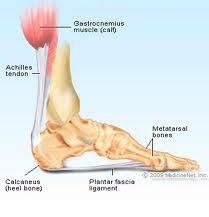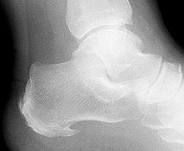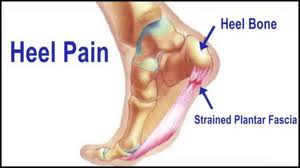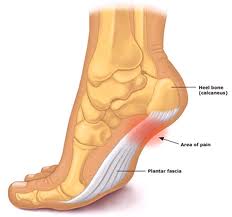Heel spurs can be the cause of significant heel pain. Believe it or not, you probably have bone spurs without knowing it, because most bone spurs themselves cause no symptoms.
But if a spur on your heel bone happens to rub on soft tissue like the plantar fascia, causing plantar fasciitis, or worse yet on a nerve, the tissue breaks down, causing swelling, pain, and tearing. Bone spurs in the foot can also cause corns and calluses as tissue builds up around the spur.
When your heel bone is exposed to repeated activities that put stress on your feet, downward pressure from being overweight, or stress from wearing poorly fitting shoes, calcium deposits form on the bottom of the bone. These deposits build on each other, eventually causing a spur-shaped deformity called a calcaneal spur (calcaneal is the medical term for your heel bone). Those who are obese or have flat feet, and women who frequently wear high heels are most susceptible to heel spurs.
Although many people with plantar fasciitis have heel spurs, spurs themselves are not the cause of plantar fasciitis pain. In fact, one out of 10 people have heel spurs, but only 5 percent of these have foot pain. Because the spur is not the cause of plantar fasciitis, the pain can be treated without surgically removing the spur.
What are the symptoms of heel spurs?
- Pain on the bottom of the foot near the heel
- Pain during the first few steps upon getting out of bed in the morning, or after a long period of rest. The pain subsides after a few minutes of walking
- Increased pain after, but not during exercise or activity
How are heel spurs treated?
Heel spurs do not require treatment unless they are causing pain or damaging other tissues. When indicated, treatment may be directed at the causes, the symptoms, or the spurs themselves. More than 90% of patients with plantar fasciitis caused by a heel spur will improve within 10 months of starting simple, non-surgical treatments.

Rest: Decrease or stop the activities that make the pain worse, such as running on hard surfaces
Ice: 20 minutes 3 to 4 times a day
Weight Control: If the heel spur is due to obesity, losing weight will take some of the pressure off the foot
Over the counter medication: Non-steroidal anti inflammatory medicines such as ibuprofen (advil) or naproxen (aleve)
Better shoes and orthotics: Shoes with thick soles and extra cushioning can reduce pain. Pre-made or custom orthotics (shoe inserts) are helpful as well as soft silicone heel pads to elevate and cushion your heel.
Night splints. Most people sleep with their feet pointed down, which relaxes the plantar fascia. This is one of the reasons for morning heel pain. A night splint stretches the plantar fascia while you sleep and does not have to be used after the pain subsides
Physical therapy. We may suggest physical therapy to stretch your calf muscles, heel cord, and plantar fascia
Extracorporeal shockwave therapy (ESWT): High-energy shockwaves stimulate the healing process in damaged plantar fascia tissue. ESWT is noninvasive—it does not require a surgical incision.
If the bone spur continues to cause pain, we may suggest a steroid injection at the painful area to reduce pain and inflammation of the soft tissues next to the bone spur. If pain continues, surgical intervention may be recommended.
Remember, no pain is normal. If you have persistent heel pain, your body is telling you that something’s wrong.





